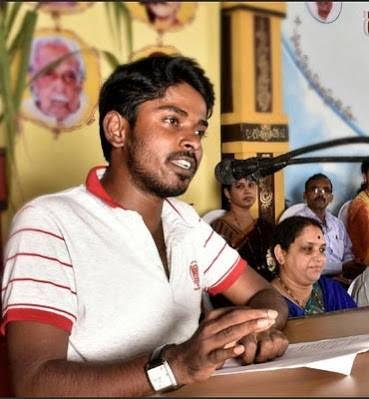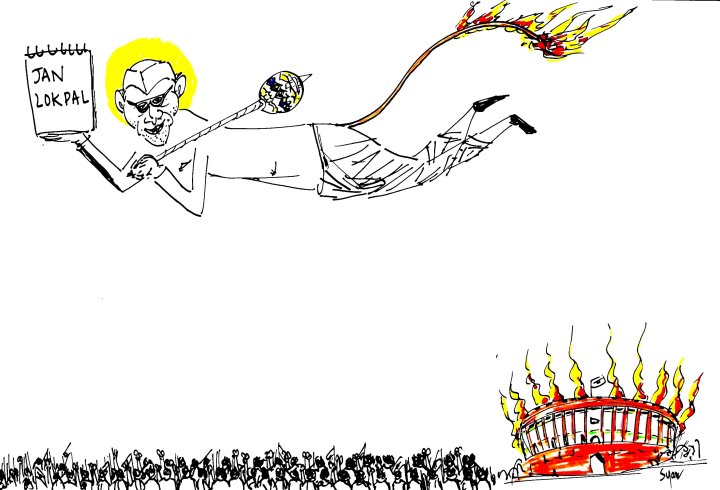Shafiullah Anis
Introduction
 In the waiting room of a hospital in Jamia Nagar, Delhi, I came across The Companion magazine featuring Malcolm X and Rohith Vemula on the cover. This was March 2017 edition and had covered opinion pieces and articles on a range of issues such as disappearance of Najeeb from JNU, Education, Hijab and Muslim women etc. Before I could read the article on Malcolm X, who was featured on the cover and for whom I picked the magazine to read, I came across an interview of SIO president, Nahas Mala, by Kashif Mansoor entitled ‘It is all about justice and dignity’.
In the waiting room of a hospital in Jamia Nagar, Delhi, I came across The Companion magazine featuring Malcolm X and Rohith Vemula on the cover. This was March 2017 edition and had covered opinion pieces and articles on a range of issues such as disappearance of Najeeb from JNU, Education, Hijab and Muslim women etc. Before I could read the article on Malcolm X, who was featured on the cover and for whom I picked the magazine to read, I came across an interview of SIO president, Nahas Mala, by Kashif Mansoor entitled ‘It is all about justice and dignity’.
In the interview, Mala talks about various issues such as alliance with Ambedkarite organizations, focus on education and entrepreneurship, SIO as a Daawah organization etc. He also talks in detail about caste in Indian society and the logic behind a separate organization for women, GIO. However, when it came to the question of caste system among Muslims in India, Mala falters. In response to Kashif Mansoor’s question, “As you have told caste is a problem and SIO is struggling for eradication of caste by joining #JusticeForRohith movement, there are many castes among Muslims. Does SIO address the caste question among Muslims? Does it ever want to address the issue? What is SIO’s take on Pasmanda Muslim movement?” Mala states the religio-normative view of Islam on equality of all human beings and claims that “Being a Muslim and claiming to be adherent to Islamic ideology, nobody can say that Islam gives any such social status to anybody and classifies people on such social strata except fear of Allah”. However, he continues saying “If there exists such stratification you have to struggle for its eradication.”
Although Kashif had specifically asked about SIO’s role in eradication of caste and about the intent of organization in its eradication, Mala misses this opportunity to provide any specific detail about any targeted campaign, or future course of action. Later on, he makes a claim that the Pasmanda Movement’s “understanding of caste among Muslims is problematic as they trace it to the Quranic text and Prophetic traditions. But it can’t be justified on the basis of any Prophet’s instances or Quranic message”. Unlike SIO, which claims to be a Daawah organization, the Pasmanda movement is a socio-political effort of the marginalized community, and therefore, it was expected of SIO to have a policy on caste system among Muslims instead of maligning and gaslighting the movement of dignity of the most marginalized. It needs to be pointed out that Mala did make his claims without sharing any substantial evidence or quoting the source of his information (Mansoor, 2017).
An attempt to gaslight a movement by delegitimization
The claim (without evidence) that the Pasmanda movement traces caste to Quranic text and Prophetic tradition is a gross misrepresentation and a gaslighting attempt by the SIO president. This effort by SIO to make Pasmanda movement appear anti-Islamic, and thus to delegitimize the efforts made by the most marginalized within Muslim society is condemnable. I think it is important to listen to Ali Anwar, a leading voice of the Pasmanda Movement, who had already answered similar questions earlier, when he said, “We Muslim Dalit and Backward Castes are ‘believing Muslims’: we take our faith in Islam seriously. Islam … stands for social equality and justice. It is completely opposed to social hierarchy. So when we are protesting against inequality and injustice, how can we be said to be going against Islam? On the contrary, what we are doing is, in my view, actually mandated by our religion. On the other hand, those who keep silent on the plight of the Muslim Dalit and Backward Castes are actually working against Islam, for they are indifferent to its mandate of social justice and inequality.” (Ansari, 2016)
On the one hand, Mala recognizes caste in Indian society and says “Caste is a social reality in India. It is a notion and state of mind. You can’t disregard caste problems in India. Without treating caste you will not be able to solve society’s issues”, and on the other hand he skips questions on his organization’s role in eradicating caste problem within the Muslim society. His organization has an ‘unconditional’ alliance, which he refers to as ‘dignity politics’, with Ambedkarite organizations yet SIO fails to address questions posed on the dignity and social justice of its own co-religionists, who are marginalized for centuries. Moreover, the assertion of Pasmanda is maliciously made to appear as anti-Islamic in a single stroke. There are several inferences that can be drawn from these attempts to delegitimize the movement, however, SIO must ponder on how long this strategy of gaslighting will bear fruit? How can there be an alliance with Dalits without addressing the demands of Dalit Muslims, for example?
Issues of justice, Islamic traditions and parallels with other movements
Having said that, I would like to move this discussion ahead, and beyond SIO and its president’s unfortunate comments. The issues of social inequalities and justice cannot be settled on a normative level. One has to engage on the level of practice to even start the discussion. Therefore, I would leave behind the simplistic Islamic/anti-Islamic binaries to a more nuanced discussion of how caste became an issue amongst Indian Muslims. And how the religious structures that derive their strengths from religious authorities fostered and nourished caste. And let us be honest enough to not shy away from critiquing those traditions that are …err…unislamic.
Pasmanda movement is not the only discourse that has attempted to critique Islamic traditions and history, and I believe, it won’t be the last. There is a similar tradition of scholarship on gender justice in Islamic history as well as in contemporary times. The voice against patriarchal interpretation of Islamic texts and traditions was raised not only by modern Islamic feminists but also by jurists like Al-Tabari. Fatima Mernissi in her illustrious work ‘Women and Islam: An Historical and Theological enquiry’ historicized and questioned Hadiths and attributions that were misogynistic. In her book she questioned the authenticity of some of the misogynistic Sahih Bukhari Hadiths e.g.:
“Those who entrust their affairs to a woman will never know prosperity.” [Bukhari, Sahih, vol. 4, p. 226]
Her investigation revealed that the jurists of first century Hijri had hotly debated and contested this Hadith yet this misogynistic Hadith is considered as sacred, unassailable truth. “What could have been reason behind depriving women of their power of decision making and for justifying their exclusion from politics?” she asks. This is not an isolated Hadith, and she had presented her irrefutable evidence and arguments in many similar cases. So, the question arises, from where did misogyny enter into the religion?
Quite parallel to misogynistic interpretations in Islamic traditions, the issues of caste can also be traced to early Islam, just after the time period of Prophet and the four guided Caliphs. Masood Alam Falahi (Falahi, 2009) traces the beginning of caste consciousness during the Umayyed Caliphate (661-750) that came after the caliphate of fourth Guided Caliph, Ali Ibn Abi Talib. Falahi writes (Falahi 2009):
We can see the evidence of [emergence of] caste system in Umayid period. For example:
1. The governor of Iraque Hajjaj bin Yousuf ordered that no non-Arab can be an Imam in Kofah.
2. The governor of Basrah Bilal bin Abi Burdah whipped a great non Arab religious scholar ‘Abdullah bin ‘Awn’ because he married an Arab lady.
3. A Bedouin of Bano Sulaim (name of a tribe) married his daughter with a non-Arab new Muslim. Mohammad bin Basheer Al-Kharji went to Madinah and complained to the governor of Madinah “Ibrahim bin Hisham bin Isma’il bin Hisham bin Mughirah. The governor separated between wife and husband and whipped that new Muslim and shaved his beard and eyebrow.
I think this reaction is due to the attitude of Persian people’s “Sho’uobiyah” movement against Arab and participation of non-Arabs in the wars against Umayyid caliphate in support of ahl-e-bait (Sayeds).
The Abbasid dynasty finds its root of establishment in caste system itself. The main campaigner of this dynasty was Abu Muslim Khurasani, (Khurasan: a city in Iran) who already had a grudge against the teaching of Islam. Nafs Zakiyah – one from Ali Rz.’s Family – accepted this fact. He, once in his letter to Abbasid Caliph Mansoor, wrote:
“The caliphate is our right. You claimed it through us. You took the support of our shias to gain it. You got it through our behalf only.”
Even Caliph Mansoor recognizes the facts that the Abbasid movement raised the honour of Ahle Bait (Sayed, the family of Ali Rz. through Hazrat Fatima, the daughter of Prophet Mohammad P.B.U.H). He replied to Nafs-e-Zakiah:
“….We. [Abbasid movement]…. raised the superiority of the elders of Ahle Bait.”
The caste system was on its highest of peaks, during this period. Even Abbasids and Fatmites (people of Ahle bait) commented on each other caste on a regular basis, trying to prove one another of a lower status. The three imams Imam Abu Hanifah, Imam Shafy’ee, and Imam Ahmad bin Hanbal, used to live in the remote areas of the city of Prophet, Madinah, where caste system ran in every vein. It even reflected in their fatwas. But as Imam Malik lived in the heart of Madinah, he took his stand totally against casteism. Compilation of Fiqh was started during the Abbasid period and so one can find numerous fatwas dominated by caste system.
Falahi’s investigation conclusively refutes the claim that caste system is merely an export of Hindu caste system. The anthropological work done by Abdul Hamid el-Zeini (El-Zeini, 1977) finds more evidences of an endogamic religious elite class structure established by Sayeds (Sadah):
“In the case of Southern Arabia, it is the Sadah, or descendents of the Prophet Mohammed, who traditionally stand as the religious elite. The Sadah define themselves as a group according to their genealogical descent from the Prophet. Through claiming a necessary correspondence between religious knowledge and the concept of privileged descent, they possess the authority both to create the content of religious ideology and to enforce this ideology among the people.
According to the Sadah, descent from the Prophet passes on to them a superior knowledge with which they create the content of a system of religious symbols. They believe that their Islam is not a mere interpretation of the Quran or sacred tradition of the Prophet but rather that it is the real Islam inherited from their ancestor, Muhammed. They claim to be not only the mediators between man and God but the direct representation of God’s reality on earth, restoring order to the world and defining the meaning of both nature and ordinary man according to the Word of God. Access to this knowledge is further controlled in a closed system of religious education. Although theoretically such training is open to all social groups by tradition, it is available only to the Sadah or to those whom they consider capable of religious knowledge, the Mashaikh.
The Sadah then enforce their own dominating position and perpetuate the religious ideology which they have constructed by means of certain social and political controls over the other groups within their society, and they legitimize these powers in terms of religious authority…They further infiltrate and control the other social groups through religious justification of the Kafa’ah marriage system which allows marriage only within the same social group or with women of a lower social stratum, in which case the children take the status of their father. No woman, however, may marry into a lower social group and diminish the social status of her children. By following this system, the Sadah create the delicate balance of being able to establish the controls of kinship within all social groups of lower birth and yet maintain their own higher status by claiming the children from such marriages as their own. By means of these controls based ultimately on religious ideology, the Sadah accumulated political power, social prestige, and economic superiority”
In the light of these scholarly works, can we really differentiate between the priestly class of Sayeds from that of Brahmins when it comes to maintaining higher status to enjoy political power, social prestige and economic superiority?
~
References
1. Ansari KA. (2016). A tale of two mosques. HIMAL South Asian. December 6, 2016. http://himalmag.com/a-tale-of-two-mosques/?currentPage=all Accessed March 30, 2017.
2. El- Zein, A. H. (1977). Beyond Ideology and Theology: the Search for the Anthropology of Islam. Annual Review of Anthropology, 6(1), 227–254.
3. Falahi MA. (2009). Caste and caste based discriminations Among Indian Muslims. September, 2009. http://sas-space.sas.ac.uk/5664/1/AHRC_16,_Caste_and_Caste_Based_Discriminations_Among_Indian_Muslims.pdf Accessed March 31,2017
4. Mansoor K. (2017). It Is All About Justice And Dignity – Nahas Mala. March 31, 2017 http://thecompanion.in/justice-dignity-nahas-mala/ Accessed March 31, 2017.
5. Mernissi F. (1991). Women and Islam: An Historical and Theological Enquiry.
~~~
Shafiullah Anis is an IIM Lucknow alumnus, Urdu poet, and a researcher interested in the Marketplace, Society, and Culture. Email: shafiullahanis@gmail.com










